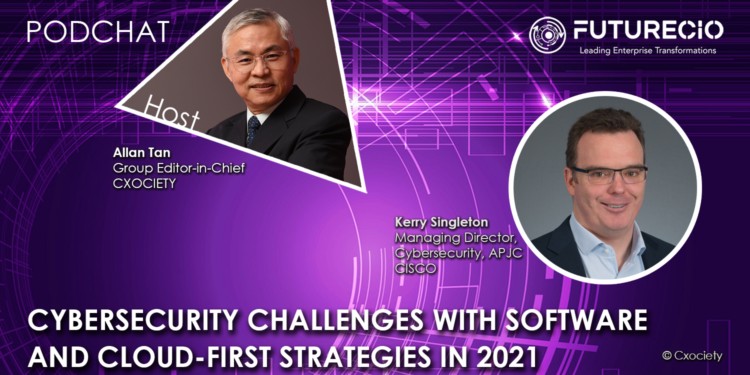One of the conclusions of the Cisco 2021 Security Outcomes Study for APJC is that organizations that proactively upgrade technology report more security success. Among the 2,110 respondents to the survey, only 36% reported being successful navigating cybersecurity challenges in today’s remote-first world with software and cloud-first strategies.
In describing the disparity in successfully combating cybersecurity, Kerry Singleton, managing director, Cybersecurity, APJC, for Cisco attribute this to the differing levels of maturity across Southeast Asia. The other factor he reckoned has to do with prevailing local laws.
Will upgrading security solutions fix the problem?
Singleton confided that customers today are having conversations around cloud-delivered security. “When we talk about upgrade, it’s also changing from traditional on-prem based security solutions to cloud-delivered solutions.”
“It is also about adding new things to protect from new attack vectors,” he added as he explained the multiple layers that make up cybersecurity. “When we are talking about upgrading, we are also thinking about how to protect ourselves from different layers in an attack.”
Extending security from the company to its customers
Singleton noted that doing transactions in a medium such as the Internet necessitates the use of encryption.
“There is some formal type of handshake between two persons where there is an opportunity to encrypt the message communication from end to end which means nobody can eavesdrop or do a man-in-the-middle attack.”
He emphasised the importance of having a security framework when it comes to cybersecurity. “When we think about cybersecurity, it is difficult for the executives to get into the details of every single component. Having a framework to follow puts structure around how they protect themselves,” explained Singleton.
Security in the face of sanctioned shadow IT
Singleton acknowledged that Bring Your Own Device (BYOD) and remote working have expanded the attack surface. Compounding the situation is the sanctioned use of shadow IT that give businesses the ability to respond quicker to changing customer behaviour.
“Having good tools in place so you can see every connection going out of the network and every user that is authenticated into the network, allows you to get a very good picture of your exposure from a shadow IT perspective.”
He commented that it is possible to assess the risks and stop the use of applications that are malicious or encourage sensitive data to be shared insecurely out of the organization.
Securing the hybrid operating model
Singleton lists the three pillars of cybersecurity as protect, detect and respond. Already much has been investment around protect. This includes firewalls, VPNs, endpoint solutions, web gateways and DNS solutions.
The challenge he noted is attaining visibility of what is happening, and being able to detect and respond to threats.
“We have a lot of customers speaking to us about how to look at a set of products which are integrated together and detect threats regardless of whether they are in the corporate network or a remote network, or if they are on a Wi-Fi hotspot at a café, and how do they go about responding to those threats.”
He conceded that at present this is a blind spot for a lot of C-suites. “They are not sure what is happening in those remote environments,” he added.
The more things change
As enterprises prepare for a return to a new normal, Singleton see enterprises using the opportunity to become more efficient. He believed enterprises will continue operating the way they do now – with part of the teams working remotely.
This will require organisations to look at a more permanent and long-term solution to providing security and IT services.
“We went from business continuity planning to business continuity execution overnight. We did things in a rush and there were blind spots of things we don’t have visibility into.”
“We understand we are going to do this the long-term and we need to look at a set of solutions which allow us to have the necessary cybersecurity capabilities in the longer term,” concluded Singleton.
Cybersecurity in 2021
“COVID-19 has accelerated the shift from CAPEX models to software0vased solutions that have a re-occurring OPEX models,” observed Singleton. He believed this will not slow down in 2021 as organisations use the opportunity to further digitise processes, including the way of working.
“You will see a lot of customers wanting to have deeper conversations around how they can secure the different types of workers in a better way. You will see customers having conversations around integrated architecture, not just investing heavily on protection but how they go about detecting and responding to threats,” he opined.
Click on the PodChat player above to listen to the full dialogue with Singleton.
- Let’s start off with the gist of the study. Very briefly, what is the focus of the study?
- How would you compare this security success among the countries in Asia that were part of the survey?
- One of the conclusions of the study is the linkage between successful security and proactive upgrade of technology. When you say “upgrade” does it mean “replacing older technologies”?
- Not everyone has deep pockets and most leaders, including CFOs, would want to maximise what they can extract from their investments including IT. At what point in the future, should an organisation look at replacing?
- BYOD may not be the official culprit and digital transformation may not have empowered business unit leaders. But Shadow IT is growing nonetheless. How do you enforce cybersecurity in an organization where shadow IT is encouraged by leadership?
- How do you secure the infrastructure – on-prem, off-prem and at the edge, and to do it with real-time visibility and control?
- Why is Cisco interested in cybersecurity?
- Any final thoughts around cybersecurity in 2021 – with and without COVID-19?





